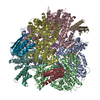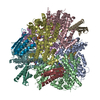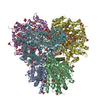[English] 日本語
 Yorodumi
Yorodumi- PDB-7u65: Structure of E. coli dGTPase bound to T7 bacteriophage protein Gp1.2 -
+ Open data
Open data
- Basic information
Basic information
| Entry | Database: PDB / ID: 7u65 | ||||||||||||
|---|---|---|---|---|---|---|---|---|---|---|---|---|---|
| Title | Structure of E. coli dGTPase bound to T7 bacteriophage protein Gp1.2 | ||||||||||||
 Components Components |
| ||||||||||||
 Keywords Keywords | HYDROLASE / dGTPase / inhibitor / complex | ||||||||||||
| Function / homology |  Function and homology information Function and homology informationpyrimidine deoxyribonucleoside salvage / dGTPase / dGTPase activity / dGTP catabolic process / nucleobase-containing small molecule interconversion / cobalt ion binding / single-stranded DNA binding / manganese ion binding / DNA replication / GTPase activity ...pyrimidine deoxyribonucleoside salvage / dGTPase / dGTPase activity / dGTP catabolic process / nucleobase-containing small molecule interconversion / cobalt ion binding / single-stranded DNA binding / manganese ion binding / DNA replication / GTPase activity / magnesium ion binding / identical protein binding Similarity search - Function | ||||||||||||
| Biological species |    Escherichia phage T7 (virus) Escherichia phage T7 (virus) | ||||||||||||
| Method | ELECTRON MICROSCOPY / single particle reconstruction / cryo EM / Resolution: 2.8 Å | ||||||||||||
 Authors Authors | Klemm, B.P. / Hsu, A.L. / Borgnia, M.J. / Schaaper, R.M. | ||||||||||||
| Funding support |  United States, 3items United States, 3items
| ||||||||||||
 Citation Citation |  Journal: Proc Natl Acad Sci U S A / Year: 2022 Journal: Proc Natl Acad Sci U S A / Year: 2022Title: Mechanism by which T7 bacteriophage protein Gp1.2 inhibits dGTPase. Authors: Bradley P Klemm / Deepa Singh / Cassandra E Smith / Allen L Hsu / Lucas B Dillard / Juno M Krahn / Robert E London / Geoffrey A Mueller / Mario J Borgnia / Roel M Schaaper /  Abstract: Levels of the cellular dNTPs, the direct precursors for DNA synthesis, are important for DNA replication fidelity, cell cycle control, and resistance against viruses. encodes a dGTPase (2'- ...Levels of the cellular dNTPs, the direct precursors for DNA synthesis, are important for DNA replication fidelity, cell cycle control, and resistance against viruses. encodes a dGTPase (2'-deoxyguanosine-5'-triphosphate [dGTP] triphosphohydrolase [dGTPase]; gene, Dgt) that establishes the normal dGTP level required for accurate DNA replication but also plays a role in protecting against bacteriophage T7 infection by limiting the dGTP required for viral DNA replication. T7 counteracts Dgt using an inhibitor, the gene product (Gp1.2). This interaction is a useful model system for studying the ongoing evolutionary virus/host "arms race." We determined the structure of Gp1.2 by NMR spectroscopy and solved high-resolution cryo-electron microscopy structures of the Dgt-Gp1.2 complex also including either dGTP substrate or GTP coinhibitor bound in the active site. These structures reveal the mechanism by which Gp1.2 inhibits Dgt and indicate that Gp1.2 preferentially binds the GTP-bound form of Dgt. Biochemical assays reveal that the two inhibitors use different modes of inhibition and bind to Dgt in combination to yield enhanced inhibition. We thus propose an in vivo inhibition model wherein the Dgt-Gp1.2 complex equilibrates with GTP to fully inactivate Dgt, limiting dGTP hydrolysis and preserving the dGTP pool for viral DNA replication. | ||||||||||||
| History |
|
- Structure visualization
Structure visualization
| Structure viewer | Molecule:  Molmil Molmil Jmol/JSmol Jmol/JSmol |
|---|
- Downloads & links
Downloads & links
- Download
Download
| PDBx/mmCIF format |  7u65.cif.gz 7u65.cif.gz | 760.3 KB | Display |  PDBx/mmCIF format PDBx/mmCIF format |
|---|---|---|---|---|
| PDB format |  pdb7u65.ent.gz pdb7u65.ent.gz | 585.6 KB | Display |  PDB format PDB format |
| PDBx/mmJSON format |  7u65.json.gz 7u65.json.gz | Tree view |  PDBx/mmJSON format PDBx/mmJSON format | |
| Others |  Other downloads Other downloads |
-Validation report
| Summary document |  7u65_validation.pdf.gz 7u65_validation.pdf.gz | 1.3 MB | Display |  wwPDB validaton report wwPDB validaton report |
|---|---|---|---|---|
| Full document |  7u65_full_validation.pdf.gz 7u65_full_validation.pdf.gz | 1.3 MB | Display | |
| Data in XML |  7u65_validation.xml.gz 7u65_validation.xml.gz | 86.5 KB | Display | |
| Data in CIF |  7u65_validation.cif.gz 7u65_validation.cif.gz | 135.3 KB | Display | |
| Arichive directory |  https://data.pdbj.org/pub/pdb/validation_reports/u6/7u65 https://data.pdbj.org/pub/pdb/validation_reports/u6/7u65 ftp://data.pdbj.org/pub/pdb/validation_reports/u6/7u65 ftp://data.pdbj.org/pub/pdb/validation_reports/u6/7u65 | HTTPS FTP |
-Related structure data
| Related structure data |  26360MC  7u66C  7u67C M: map data used to model this data C: citing same article ( |
|---|---|
| Similar structure data | Similarity search - Function & homology  F&H Search F&H Search |
| Other databases |
|
- Links
Links
- Assembly
Assembly
| Deposited unit | 
|
|---|---|
| 1 |
|
- Components
Components
| #1: Protein | Mass: 59470.863 Da / Num. of mol.: 6 Source method: isolated from a genetically manipulated source Source: (gene. exp.)  Strain: K12 / Gene: dgt, b0160, JW0156 / Plasmid: pET30-Ek / Production host:  #2: Protein | Mass: 10595.868 Da / Num. of mol.: 6 Source method: isolated from a genetically manipulated source Details: The additional N-terminal sequence is retained after cleavage of the expression tag with TEV protease. Source: (gene. exp.)   Escherichia phage T7 (virus) / Gene: 1.2 / Plasmid: pDest-566 / Production host: Escherichia phage T7 (virus) / Gene: 1.2 / Plasmid: pDest-566 / Production host:  Has protein modification | N | |
|---|
-Experimental details
-Experiment
| Experiment | Method: ELECTRON MICROSCOPY |
|---|---|
| EM experiment | Aggregation state: PARTICLE / 3D reconstruction method: single particle reconstruction |
- Sample preparation
Sample preparation
| Component |
| |||||||||||||||||||||||||
|---|---|---|---|---|---|---|---|---|---|---|---|---|---|---|---|---|---|---|---|---|---|---|---|---|---|---|
| Molecular weight |
| |||||||||||||||||||||||||
| Source (natural) |
| |||||||||||||||||||||||||
| Source (recombinant) |
| |||||||||||||||||||||||||
| Buffer solution | pH: 8 | |||||||||||||||||||||||||
| Buffer component |
| |||||||||||||||||||||||||
| Specimen | Embedding applied: NO / Shadowing applied: NO / Staining applied: NO / Vitrification applied: YES Details: Frozen stocks were thawed and mixed to a final concentration of 1.25:1 Gp1.2 to dGTPase (monomer) | |||||||||||||||||||||||||
| Specimen support | Grid material: GOLD / Grid mesh size: 300 divisions/in. / Grid type: UltrAuFoil R1.2/1.3 | |||||||||||||||||||||||||
| Vitrification | Instrument: LEICA EM GP / Cryogen name: ETHANE / Humidity: 95 % / Chamber temperature: 290 K |
- Electron microscopy imaging
Electron microscopy imaging
| Experimental equipment |  Model: Talos Arctica / Image courtesy: FEI Company |
|---|---|
| Microscopy | Model: FEI TALOS ARCTICA |
| Electron gun | Electron source:  FIELD EMISSION GUN / Accelerating voltage: 200 kV / Illumination mode: FLOOD BEAM FIELD EMISSION GUN / Accelerating voltage: 200 kV / Illumination mode: FLOOD BEAM |
| Electron lens | Mode: BRIGHT FIELD / Nominal magnification: 45000 X / Nominal defocus max: 1750 nm / Nominal defocus min: 750 nm / Cs: 2.7 mm |
| Specimen holder | Cryogen: NITROGEN / Specimen holder model: FEI TITAN KRIOS AUTOGRID HOLDER |
| Image recording | Average exposure time: 8.4 sec. / Electron dose: 54 e/Å2 / Detector mode: COUNTING / Film or detector model: GATAN K2 SUMMIT (4k x 4k) / Num. of grids imaged: 1 / Num. of real images: 1638 |
| Image scans | Width: 3838 / Height: 3710 / Movie frames/image: 60 |
- Processing
Processing
| EM software |
| ||||||||||||||||||||||||||||||||||||
|---|---|---|---|---|---|---|---|---|---|---|---|---|---|---|---|---|---|---|---|---|---|---|---|---|---|---|---|---|---|---|---|---|---|---|---|---|---|
| Image processing | Details: 1404 micrographs used after manually eliminating micrographs with poor CTF fit. | ||||||||||||||||||||||||||||||||||||
| CTF correction | Type: PHASE FLIPPING AND AMPLITUDE CORRECTION | ||||||||||||||||||||||||||||||||||||
| Particle selection | Num. of particles selected: 732832 / Details: Laplacian-of-Gaussian auto-picking | ||||||||||||||||||||||||||||||||||||
| Symmetry | Point symmetry: D3 (2x3 fold dihedral) | ||||||||||||||||||||||||||||||||||||
| 3D reconstruction | Resolution: 2.8 Å / Resolution method: FSC 0.143 CUT-OFF / Num. of particles: 114127 / Algorithm: FOURIER SPACE / Num. of class averages: 93 / Symmetry type: POINT | ||||||||||||||||||||||||||||||||||||
| Atomic model building | Protocol: RIGID BODY FIT / Space: REAL Details: E. coli dGTPase crystal structure (PDB ID: 4XDS) and T7 bacteriophage NMR structure (PDB ID: 2MDP) models were fit into the EM map using Chimera for subsequent building. After an initial ...Details: E. coli dGTPase crystal structure (PDB ID: 4XDS) and T7 bacteriophage NMR structure (PDB ID: 2MDP) models were fit into the EM map using Chimera for subsequent building. After an initial round of real-space refinement, the Gp1.2 N-terminus was re-built into the density using Coot. | ||||||||||||||||||||||||||||||||||||
| Atomic model building |
|
 Movie
Movie Controller
Controller





 PDBj
PDBj

